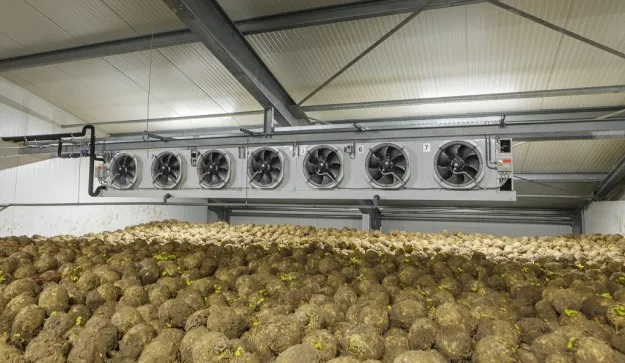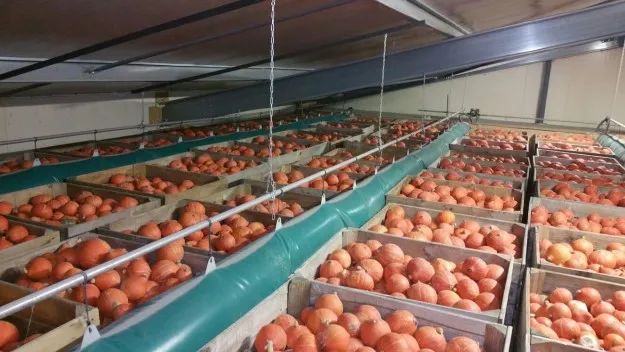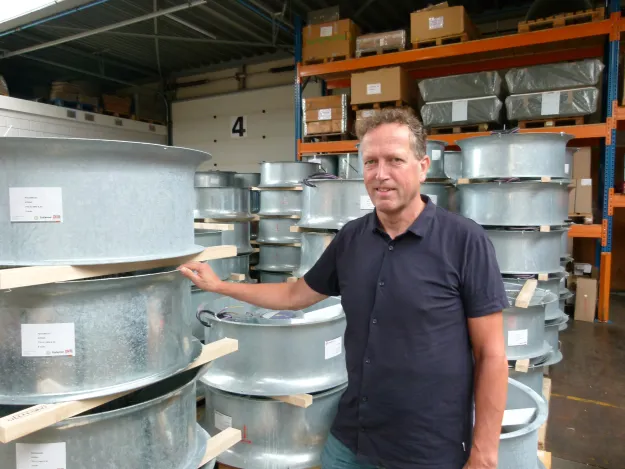"Those beans for Jumbo, [a supermarket chain in the Netherlands] that come out of season from Zambia? They're kept fresh there in a Tolsma refrigerator." That's according to Tolsma's senior storage specialist Huub Maerman. He easily lists local and overseas projects. In these, this Dutch company has set up storage facilities. These are for products other than potatoes, onions, and carrots. These are the products this storage specialist is mainly known for in the Netherlands.
Sweet potatoes are one of the newcomers. "These are easier to store than grow. You store them at about 13°C. So, under Dutch conditions, you don't need refrigeration. They can just be stored in standard crates. But because it's a vulnerable crop, damage repair requires significant attention. The air exchange and CO₂ measurements are very precise. And to minimize moisture loss, the RH must be closely regulated and remain around 90%. For pumpkins, the RH has to be considerably lower."

Condensation drying
According to Huub, there's been an increased interest in the condensation drying of stored celeriac in recent years. That's easily explained, he says. "With celeriac, you must first of all be able to cool quickly. Sometimes a batch still has a lot of life. The temperature can rise by as much as a degree within a day."
"But you also need drying capacity. You don't want the plants to go moldy. Then condensation drying is ideal." Condensation drying is perfect for garlic preservation, too, according to Maerman. "You store that at -3°C with an RH of 70%. You can't achieve that with cooling alone."
VItal early weeks
Huub and his colleagues have years of experience. This has taught them that those first weeks are vital for good storage results. That's true for all agricultural products. "A good beginning is half the battle won, also in storage. You have to be on top of things from the start. You must observe closely how the product arrives and respond accordingly. Sometimes, for example, carrots are brought in in October under fairly warm conditions."
"Then it's crucial to cool them quickly. Carrots don't have a peel. So, they lose a lot of moisture at high temperatures. But some products arrive relatively dry, such as pumpkins. These, too, require significant attention immediately after they're stored. Let things slip, and you can easily get mold or bacteria issues." Tolsma has in-house storage knowledge for all these 'special' products. "And if we don't know something, we just dive in," laughs Huub. "We don't say no easily at Tolsma."

Direct contact with clients
This storage specialist is also keen to find solutions regarding storage techniques. "We make everything ourselves, so can switch quickly. And we have direct contact with clients. Communication about a job, therefore, always runs smoothly. There's no one go-between, and half a word is usually enough. You always have a fixed point of contact with us too."

Maerman points out that Tolsma isn't solely focused on large, new installations. "We regularly set up small cells that store all kinds of products. These are for organic growers or people with farm stores. The 'local for local' trend has boosted that. And we also frequently modify existing storage facilities. For instance, crop farmers are currently opting for mechanical cooling. That's in combination with the new sprout inhibitors. That can often be very well achieved in existing storage facilities," Huub concludes.
Source: Tolsma-Grisnich
